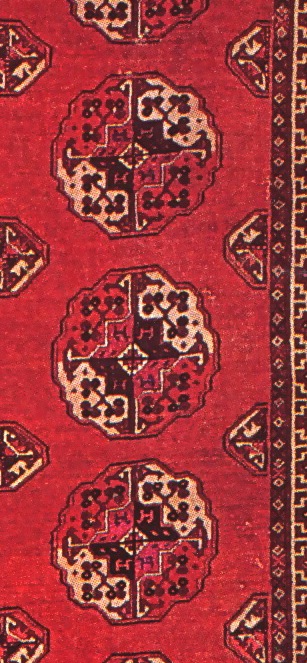Hi Steve,
It is not easy to find pics
convincingly showing bleed of natural dyes.
The carpet must
pre-date synthetic dyes, without any possible discussion («Unanimous rug
experts»: a huge oxymoron).
To remain on the safe side, I looked only
for rugs woven, most likely, before 1800.
Even on good pics it
might be difficult to differentiate between bleed and showing through of
red- or brown weft at places where pile has been damaged. Thus the chosen
carpets must be in such a good shape that we can safely assume that no
pile is missing.
A seemingly undamaged pile would give us a fair
chance that no re-piling was ever performed with lousy, bleeding synthetic
acid dyes.
On pics, it is nearly impossible to differentiate
between a small bleed of yellow- or yellow brown colors into white pile
and any normal shade variation of white wool, or traces of dirt or
spilling. I believe that only a red bleed could be clearly identified as
such. Besides, except blood and rusty water, most possible red stains are
likely to be quickly bleached out by light (red wine pigment for example,
even the quality of port wine found in British gentlemen's
clubs).
The following examples might raise at least a small doubt
about the iron rule «natural dyes never bleed»:
Salor khali. XVIII.
The Hermitage, Saint Petersburg. E. Tzareva. Rugs and Carpets from Central
Asia. Page 29


The white areas of 4 guls seem
contaminated with traces of red dye.
2.Salor chuval.
XVIII. Museum of Ethnography, Saint Petersburg. E Tzareva. Rugs and
Carpets from Central Asia. Page 33

Quite clear case of red bleed to
me.
The next Salor chuval on same page also shows highly suspect
stains. Salor were not the most lousy dyers on earth, so bleed must have
happened on the production of less gifted weavers too, when exposed to
exceptional conditions.
3.Karapinar. XVIII. Sovereign
Carpets. E. Concaro & A. Levi. Page 41.

It looks as if we would have a
red bleed, both in white- and in yellow pile.
I can’t see how this
could be explained by abrash, sheep blood, Pinot Noir spilling, weft
showing through or photographic aberrations. Do you?
The red
contamination appears on a few knots only, woven at intervals of several
days (40-50 rows). This would be a rather peculiar type of
abrash!
The bleeding, saturated black was probably made with
indigo, over-dyed with madder, perhaps on a greyish or brownish wool.
4. Ushak with Lotto pattern. XVII. Kunstauktionshaus F. Nagel.
286. Tafel 157.

Again a rather credible red bleed
in a classical carpet.
To settle the matter for good, one of the
following tests should be performed on pre-1800 carpet dyed wool:
1)
Performing AATCC- or ISO wash fastness- or so called "water severe" tests
at 30°C, 50°C and 90° C for example.
2) Analysis of the apparent bleed
by HPLC and proving that it is indeed alizarine.
Alternatively,
3)
Getting a competent and trusted dyer of natural dyes to dye wool with
madder and perform these tests on it .
Of course, no Museum curator
in his right sense would offer his support for option 1) and 2), but
perhaps a mad or drunk one can be found.
Best regards
Pierre